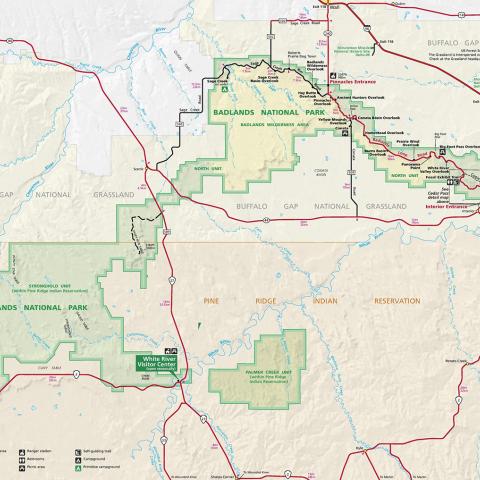
Bison on Friday were able to move onto 22,000 additional acres at Badlands National Park/NPS
Bison at Badlands National Park in South Dakota have gained 22,000 more acres to roam, and visitors could have a better chance of seeing the iconic animals that are heading back onto ground their kind haven't roved since the 1870s.
During a ceremony held Friday during the season's first snowfall, four bison bulls bolted from the back of a trailer and headed onto the new range made possible through private fund-raising that raised nearly $750,000 to pay for 43 miles of fence in the north end of the national park.
There are roughly 1,200 bison roaming the western end of the park's North Unit. While a fence had blocked them from moving east, the new fencing allowed the park to take that blocking fence down. While the four bulls were trucked over to the release point for Friday's celebration of the new range, the other bison are going to be allowed to meander over on their own.
By returning bison to this landscape and expanding the current bison range, the National Park Service is realizing a long planned effort that will contribute to the health and genetic integrity of the herd and continued health of the prairie in the North Unit of Badlands.
Though the snow, ice, and significant South Dakota wind limited the participation of people at the ceremony held at the Pinnacles Overlook just south of Wall, the bison were unconcerned by the weather during their release onto the grounds of their ancestors. The last wild bison in South Dakota was in 1877.
“Badlands National Park has had bison on the landscape since 1963, but their range has been limited for most of that time,” Superintendent Mike Pflaum said. “The National Park Service has been striving to expand the range for the bison grazing area for many years. This project would not have been possible without an important land exchange effected by The Nature Conservancy and U.S. Forest Service working with the Don Kelly family in 2014, and the generous contributions of several key park partners and their supporters and the National Park Service Centennial Challenge fund.”
Badlands National Park’s bison herd numbers around 1,200 currently, but very few visitors ever saw them because of how remote their range was. By expanding the range to areas where more people are already visiting, they will also have more opportunities for viewing, photographing, and learning about bison in their native habitat on this iconic landscape.
“The story of the American bison will continue to be part of Badlands National Park’s story for generations to come,” Pflaum said.
The addition of 43 miles of new fence along with 3 cattle guards expanding the bison grazing area by over 22,000 acres to 80,193 total acres, or 125 square miles, was made possible due to several key park partners and their supporters. The National Park Foundation, the World Wildlife Fund, Defenders of Wildlife, The Nature Conservancy, supported by Badlands Natural History Association and the Badlands National Park Conservancy, donated more than $743,000, and the National Park Service Centennial Challenge Fund contributed $475,000.
Park Service staff could not be immediately reached Friday to explain when the land exchange occurred, or what the additional $475,000 provided through the Centennial Challenge Fund was used for.




 Support Essential Coverage of Essential Places
Support Essential Coverage of Essential Places







Comments
Could we see a map?
Where did the 4 bison that,were released, come from?
the 4 bulls came from the existing herd